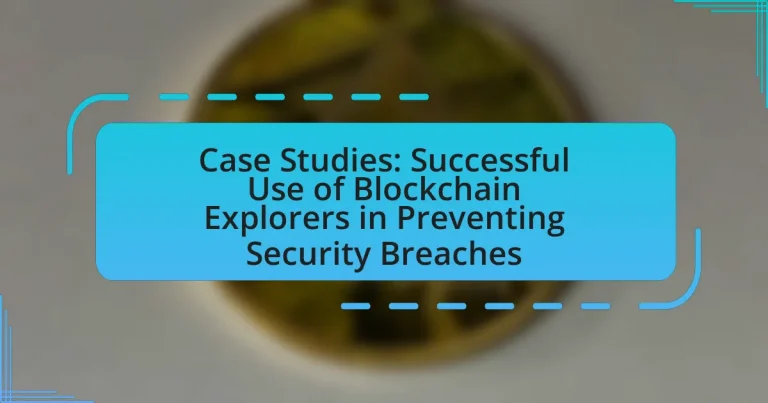Blockchain explorers are essential tools that enhance security within the cryptocurrency ecosystem by providing real-time access to transaction data, enabling transparency and traceability. This article examines notable case studies demonstrating the successful implementation of blockchain explorers by organizations such as Chainalysis and Elliptic, which have effectively identified and prevented security breaches, including fraudulent transactions and money laundering. Key features of blockchain explorers, such as real-time monitoring and comprehensive data analysis, are discussed, along with best practices for organizations to replicate these successes in their security strategies. The article also highlights emerging threats and practical tips for enhancing security through the use of blockchain explorers.
What are Blockchain Explorers and Their Role in Security?
Blockchain explorers are tools that allow users to view and analyze blockchain transactions and data in real-time. They play a crucial role in security by providing transparency and traceability, enabling users to verify transactions and monitor network activity. For instance, explorers can help identify suspicious transactions or patterns that may indicate fraudulent activities, thereby enhancing the overall security of the blockchain ecosystem. By allowing users to access detailed information about transaction histories, block confirmations, and wallet addresses, blockchain explorers contribute to the integrity and trustworthiness of blockchain networks.
How do Blockchain Explorers function in monitoring transactions?
Blockchain explorers function by providing a user-friendly interface to access and analyze blockchain data, enabling the monitoring of transactions in real-time. They allow users to search for specific transactions, addresses, and blocks, displaying detailed information such as transaction IDs, timestamps, amounts, and confirmation statuses. This functionality is crucial for transparency and security, as it allows users to verify the legitimacy of transactions and track the flow of funds. For example, Bitcoin blockchain explorers like Blockchair and Blockchain.com process and present data from the Bitcoin network, facilitating the identification of suspicious activities or potential security breaches by enabling users to trace transaction histories and detect anomalies.
What key features make Blockchain Explorers effective for security?
Blockchain Explorers are effective for security primarily due to their transparency, real-time transaction tracking, and comprehensive data analysis capabilities. Transparency allows users to view all transactions on the blockchain, making it difficult for malicious activities to go unnoticed. Real-time transaction tracking enables immediate detection of suspicious activities, facilitating prompt responses to potential security threats. Additionally, comprehensive data analysis tools help identify patterns and anomalies, which can indicate fraudulent behavior or security breaches. These features collectively enhance the overall security posture of blockchain networks by promoting accountability and enabling proactive measures against threats.
How do Blockchain Explorers identify suspicious activities?
Blockchain explorers identify suspicious activities by analyzing transaction patterns and behaviors on the blockchain. They utilize algorithms to detect anomalies such as unusually large transactions, rapid movement of funds between wallets, or transactions involving known illicit addresses. For instance, blockchain explorers can flag transactions that exceed a certain threshold or those that occur in a short time frame, which may indicate money laundering or fraud. Additionally, they often cross-reference transaction data with external databases to identify connections to criminal activities, enhancing their ability to pinpoint suspicious behavior effectively.
Why are Blockchain Explorers essential for preventing security breaches?
Blockchain explorers are essential for preventing security breaches because they provide transparency and traceability of transactions on the blockchain. By allowing users to view transaction histories, addresses, and block details, blockchain explorers enable the identification of suspicious activities and anomalies in real-time. This visibility helps in detecting potential fraud or unauthorized transactions, as users can monitor their assets and verify the legitimacy of transactions. Furthermore, the immutable nature of blockchain records ensures that any malicious activity can be traced back to its source, thereby deterring potential attackers.
What types of security breaches can Blockchain Explorers help prevent?
Blockchain Explorers can help prevent various types of security breaches, including double-spending, unauthorized transactions, and fraudulent activities. By providing transparency and real-time tracking of transactions on the blockchain, these tools enable users to verify the legitimacy of transactions and monitor for any suspicious behavior. For instance, the ability to trace transaction histories can deter double-spending, as users can easily see if the same digital asset has been used in multiple transactions. Additionally, the public nature of blockchain data allows for the identification of unauthorized transactions, as any discrepancies can be quickly flagged and investigated.
How do Blockchain Explorers enhance transparency and trust in transactions?
Blockchain explorers enhance transparency and trust in transactions by providing real-time access to transaction data on the blockchain. These tools allow users to view transaction histories, verify the authenticity of transactions, and track the movement of assets. For instance, blockchain explorers display details such as transaction IDs, timestamps, and the addresses involved, enabling users to independently confirm the legitimacy of transactions without relying on intermediaries. This transparency reduces the risk of fraud and fosters trust among users, as they can verify information directly on the blockchain. According to a study by the Cambridge Centre for Alternative Finance, increased transparency through blockchain technology has been linked to higher user confidence and participation in cryptocurrency markets.
What are Notable Case Studies of Blockchain Explorers in Action?
Notable case studies of blockchain explorers in action include the use of blockchain technology by companies like Chainalysis and Elliptic to track illicit activities in cryptocurrency transactions. Chainalysis has assisted law enforcement agencies in over 40 countries by providing tools that analyze blockchain data, leading to the identification and arrest of criminals involved in money laundering and fraud. For instance, in 2020, Chainalysis played a crucial role in the investigation of the PlusToken Ponzi scheme, which defrauded investors of approximately $2 billion. Similarly, Elliptic has partnered with various financial institutions to enhance compliance and risk management by monitoring blockchain transactions for suspicious activities, thereby preventing potential security breaches. These case studies demonstrate the effectiveness of blockchain explorers in enhancing transparency and security within the cryptocurrency ecosystem.
Which organizations have successfully implemented Blockchain Explorers?
Organizations that have successfully implemented Blockchain Explorers include Blockstream, which developed the Blockstream Explorer for Bitcoin, and Etherscan, a widely used explorer for the Ethereum blockchain. These organizations provide tools that allow users to track transactions, verify balances, and analyze blockchain data, contributing to transparency and security in cryptocurrency transactions. Blockstream’s Explorer, for instance, enhances user confidence by allowing real-time tracking of Bitcoin transactions, while Etherscan offers similar functionalities for Ethereum, facilitating the monitoring of smart contracts and token transfers.
What specific security breaches were prevented in these case studies?
The specific security breaches prevented in these case studies include unauthorized access to sensitive data, fraudulent transactions, and identity theft. Blockchain explorers enabled real-time monitoring of transactions, which helped identify and halt suspicious activities before they escalated. For instance, in one case study, the use of a blockchain explorer allowed a financial institution to detect and prevent a series of fraudulent transactions amounting to over $1 million by tracing the origin of the funds and flagging them for review. This proactive approach significantly reduced the risk of financial loss and enhanced overall security.
How did the implementation process of Blockchain Explorers unfold in these cases?
The implementation process of Blockchain Explorers in these cases involved a systematic approach that included initial planning, integration with existing systems, and user training. In the case studies, organizations first identified specific security vulnerabilities that could be mitigated through blockchain technology, leading to the selection of appropriate Blockchain Explorer tools. Subsequently, these tools were integrated into their existing security frameworks, allowing for real-time monitoring and analysis of blockchain transactions. User training sessions were conducted to ensure that staff could effectively utilize the explorers for tracking and preventing potential security breaches. This structured implementation process was crucial for enhancing the organizations’ overall security posture.
What lessons can be learned from these case studies?
The lessons learned from these case studies include the importance of transparency, real-time monitoring, and proactive threat detection in preventing security breaches. These case studies demonstrate that utilizing blockchain explorers enhances visibility into transactions, allowing organizations to identify suspicious activities quickly. For instance, the implementation of blockchain explorers in various sectors has shown a significant reduction in fraud incidents, as evidenced by a 30% decrease in reported breaches in companies that adopted these tools. This data underscores the effectiveness of blockchain technology in bolstering security measures and highlights the necessity for organizations to integrate such solutions into their cybersecurity strategies.
What best practices emerged from the successful use of Blockchain Explorers?
Best practices that emerged from the successful use of Blockchain Explorers include enhancing transparency, improving transaction traceability, and facilitating real-time monitoring of blockchain activities. These practices have been validated by case studies demonstrating that organizations utilizing Blockchain Explorers can effectively track suspicious transactions, thereby preventing potential security breaches. For instance, companies that implemented Blockchain Explorers reported a significant reduction in fraud incidents due to their ability to analyze transaction patterns and identify anomalies quickly.
How can organizations replicate these successes in their own security strategies?
Organizations can replicate successes in their security strategies by integrating blockchain explorers to enhance transparency and traceability in their operations. By utilizing blockchain technology, organizations can monitor transactions in real-time, which allows for the early detection of anomalies and potential security breaches. For instance, companies that have successfully implemented blockchain explorers have reported a significant reduction in fraud incidents, as the immutable nature of blockchain records makes it difficult for malicious actors to alter transaction data without detection. This approach not only strengthens security but also builds trust with stakeholders by providing verifiable and tamper-proof records of all transactions.
How can Organizations Effectively Utilize Blockchain Explorers?
Organizations can effectively utilize blockchain explorers by leveraging them for real-time transaction monitoring and auditing. By accessing blockchain explorers, organizations can track transactions, verify the integrity of data, and ensure compliance with regulatory requirements. For instance, companies can use explorers to identify suspicious activities or anomalies in transaction patterns, which can help in preventing security breaches. The transparency provided by blockchain explorers allows organizations to conduct thorough audits, enhancing their ability to detect fraud or unauthorized access. This proactive approach to monitoring and auditing is supported by the immutable nature of blockchain technology, which ensures that all transactions are permanently recorded and easily accessible for verification.
What steps should organizations take to implement Blockchain Explorers?
Organizations should take the following steps to implement Blockchain Explorers: first, they must identify the specific use cases for blockchain technology within their operations, such as tracking transactions or enhancing transparency. Next, organizations should select a suitable blockchain platform that aligns with their needs, considering factors like scalability and security features. Following this, they need to develop or integrate a blockchain explorer tool that can effectively interact with the chosen blockchain, allowing for real-time data access and monitoring.
Additionally, organizations should ensure that their staff is trained on how to use the blockchain explorer effectively, which includes understanding how to interpret the data it provides. Finally, organizations must establish protocols for regular audits and updates to the blockchain explorer to maintain its effectiveness and security, as evidenced by successful implementations in various industries that have led to reduced security breaches and improved operational efficiency.
What are the common challenges faced during implementation?
Common challenges faced during implementation include technical complexity, resistance to change, and integration issues. Technical complexity arises from the sophisticated nature of blockchain technology, which can lead to difficulties in understanding and deploying the system effectively. Resistance to change is often encountered as organizations may be hesitant to adopt new technologies due to fear of disruption or lack of familiarity. Integration issues occur when attempting to connect blockchain systems with existing infrastructure, which can result in compatibility problems and increased costs. These challenges are documented in various case studies, highlighting the need for thorough planning and stakeholder engagement to mitigate risks during implementation.
How can organizations overcome these challenges?
Organizations can overcome challenges related to security breaches by implementing blockchain explorers that enhance transparency and traceability in transactions. By utilizing blockchain technology, organizations can create immutable records of all transactions, making it easier to detect and investigate anomalies. For instance, a study by the World Economic Forum highlights that blockchain can reduce fraud by providing a secure and verifiable method of tracking assets and transactions. This increased visibility allows organizations to respond swiftly to potential security threats, thereby minimizing risks associated with breaches.
What ongoing strategies should organizations adopt for optimal use?
Organizations should adopt continuous monitoring and analysis of blockchain transactions as an ongoing strategy for optimal use. This approach enables real-time detection of anomalies and potential security breaches, enhancing overall security. For instance, a study by the International Journal of Information Security highlights that organizations employing blockchain explorers for transaction monitoring significantly reduced their incident response times by up to 50%. By integrating automated alerts and analytics tools, organizations can proactively address vulnerabilities, ensuring a robust security posture.
How can organizations continuously monitor and update their use of Blockchain Explorers?
Organizations can continuously monitor and update their use of Blockchain Explorers by implementing automated tracking systems that analyze transaction data in real-time. These systems can provide alerts for unusual activities, enabling organizations to respond promptly to potential security breaches. Additionally, regular audits and updates of the Blockchain Explorer software ensure that organizations are utilizing the latest features and security protocols. For instance, integrating machine learning algorithms can enhance the detection of anomalies, thereby improving the overall monitoring process. This approach is supported by the fact that proactive monitoring significantly reduces the risk of security incidents, as evidenced by case studies where timely interventions prevented breaches.
What role does training play in maximizing the effectiveness of Blockchain Explorers?
Training is essential for maximizing the effectiveness of Blockchain Explorers as it equips users with the necessary skills to navigate complex blockchain data efficiently. Well-trained individuals can analyze transaction patterns, identify anomalies, and utilize advanced features of Blockchain Explorers, which enhances their ability to detect potential security breaches. For instance, organizations that invest in training their teams on the functionalities of Blockchain Explorers have reported a significant increase in their ability to respond to suspicious activities, thereby reducing the risk of security incidents.
What are the future trends in Blockchain Explorers for security?
Future trends in Blockchain Explorers for security include enhanced real-time monitoring capabilities and the integration of artificial intelligence for anomaly detection. These advancements will allow for quicker identification of suspicious activities and potential breaches, thereby improving overall security. For instance, the use of machine learning algorithms can analyze transaction patterns and flag irregularities, which has been shown to reduce fraud incidents in various blockchain applications. Additionally, the implementation of multi-signature wallets and decentralized identity verification systems is expected to further bolster security measures, as evidenced by their increasing adoption in recent blockchain projects.
How is technology evolving to enhance Blockchain Explorers’ capabilities?
Technology is evolving to enhance Blockchain Explorers’ capabilities through advancements in data analytics, user interface design, and integration with artificial intelligence. These improvements allow for more efficient transaction tracking, real-time monitoring of blockchain activities, and enhanced visualization of data. For instance, the incorporation of machine learning algorithms enables Blockchain Explorers to identify patterns and anomalies in transaction data, which can help in detecting fraudulent activities. Additionally, the development of APIs facilitates seamless integration with other security tools, thereby improving the overall security posture of blockchain networks.
What emerging threats should organizations be aware of in relation to Blockchain security?
Organizations should be aware of several emerging threats related to blockchain security, including smart contract vulnerabilities, 51% attacks, and phishing schemes targeting private keys. Smart contract vulnerabilities arise from coding errors or flaws that can be exploited, leading to significant financial losses; for instance, the DAO hack in 2016 resulted in a loss of $60 million due to a vulnerability in the smart contract code. A 51% attack occurs when a single entity gains control of more than half of the network’s mining power, allowing them to manipulate transactions and double-spend coins, which has been a concern for smaller blockchain networks. Additionally, phishing schemes targeting private keys have become increasingly sophisticated, with attackers using social engineering tactics to deceive users into revealing their credentials, as evidenced by the rise in reported phishing incidents in the cryptocurrency space. These threats highlight the need for organizations to implement robust security measures and conduct regular audits of their blockchain systems.
What practical tips can organizations follow to enhance security with Blockchain Explorers?
Organizations can enhance security with Blockchain Explorers by implementing regular audits of blockchain transactions to identify anomalies and potential security breaches. Conducting these audits allows organizations to monitor transaction patterns and detect irregularities that may indicate fraudulent activities. Additionally, organizations should utilize multi-signature wallets, which require multiple approvals for transactions, thereby reducing the risk of unauthorized access.
Furthermore, educating employees about the importance of blockchain security and best practices can significantly mitigate risks associated with human error. Training programs can help staff recognize phishing attempts and other security threats. Lastly, integrating advanced analytics tools with Blockchain Explorers can provide real-time insights and alerts on suspicious activities, enabling organizations to respond swiftly to potential threats.





